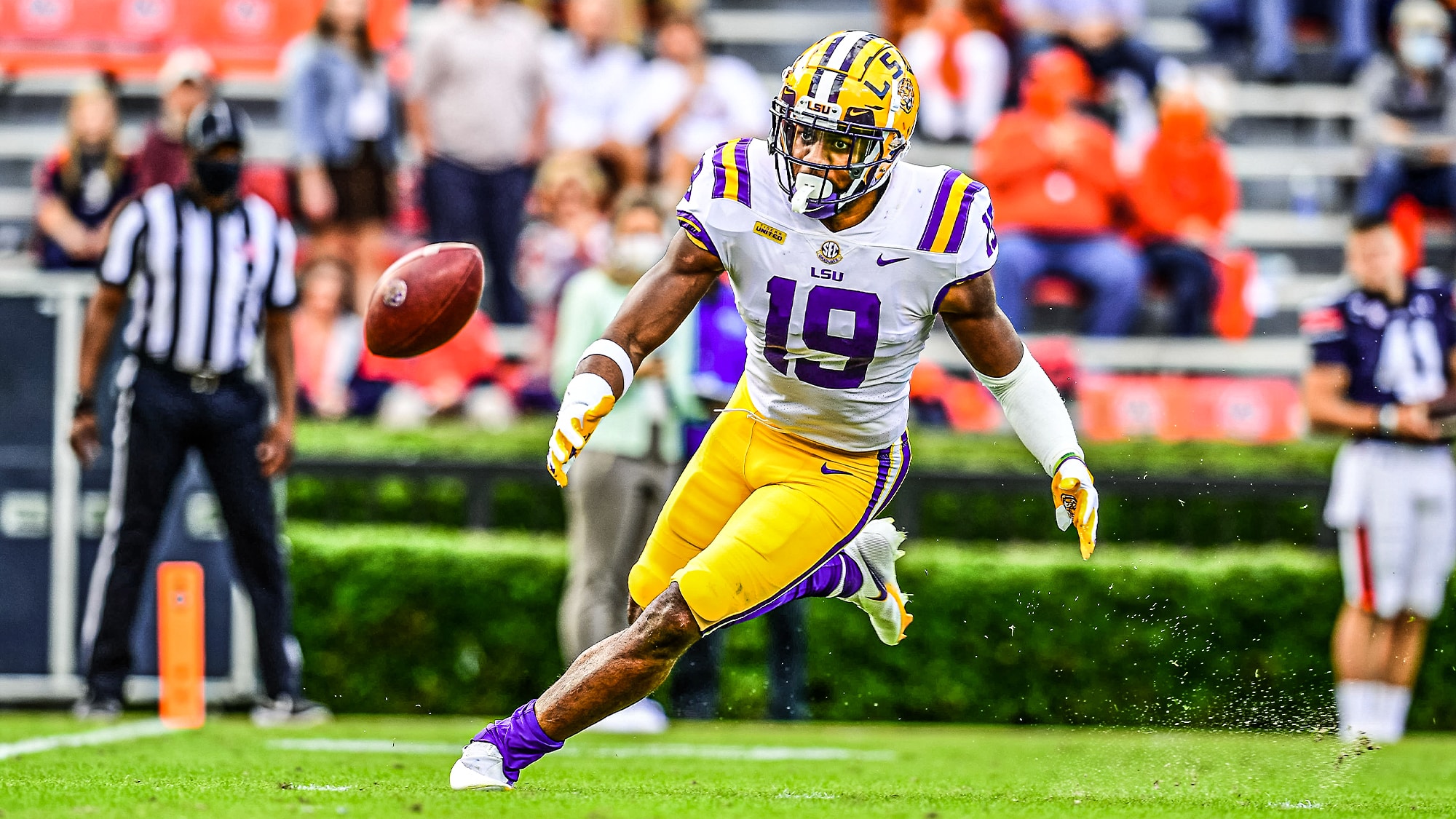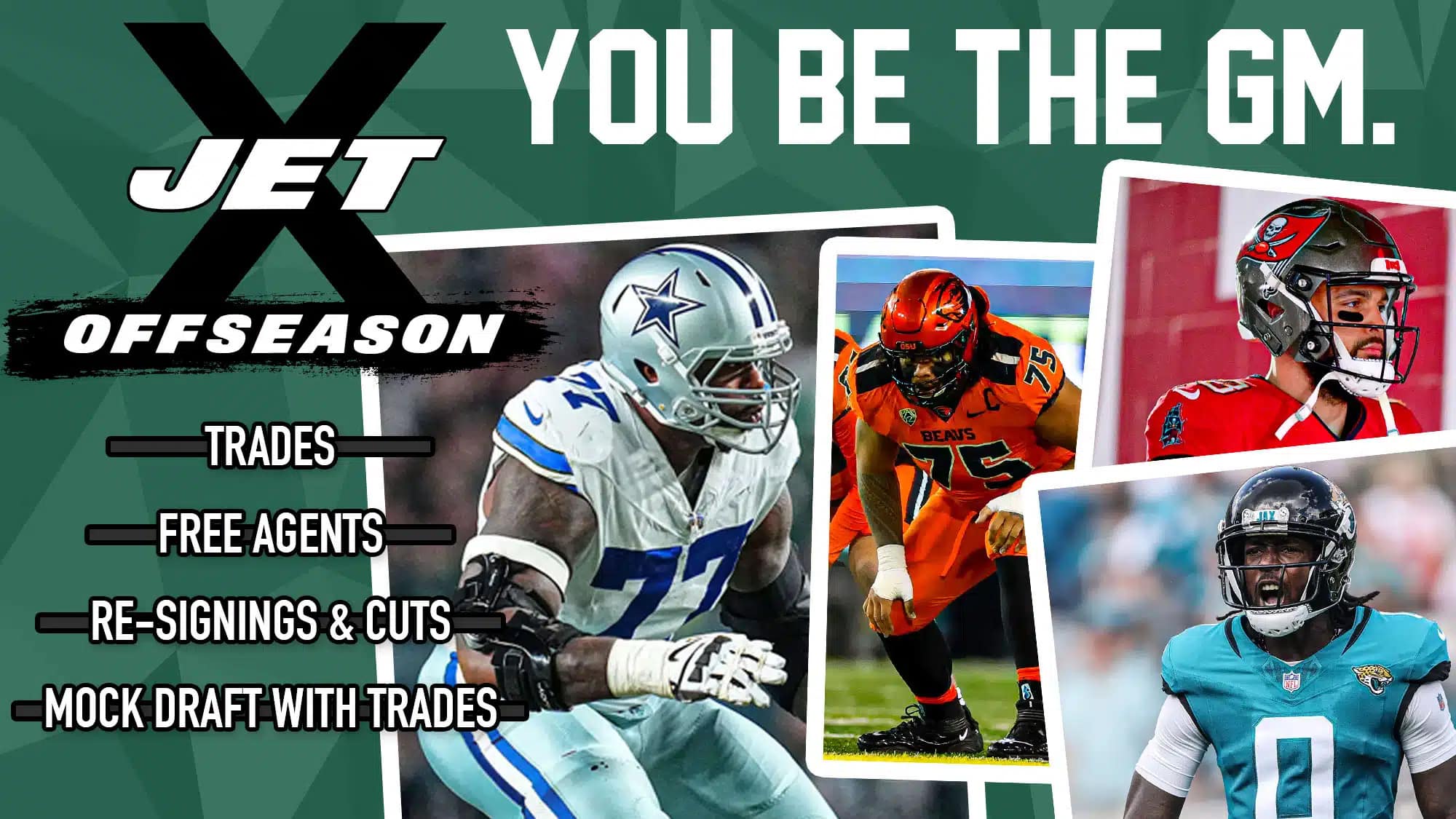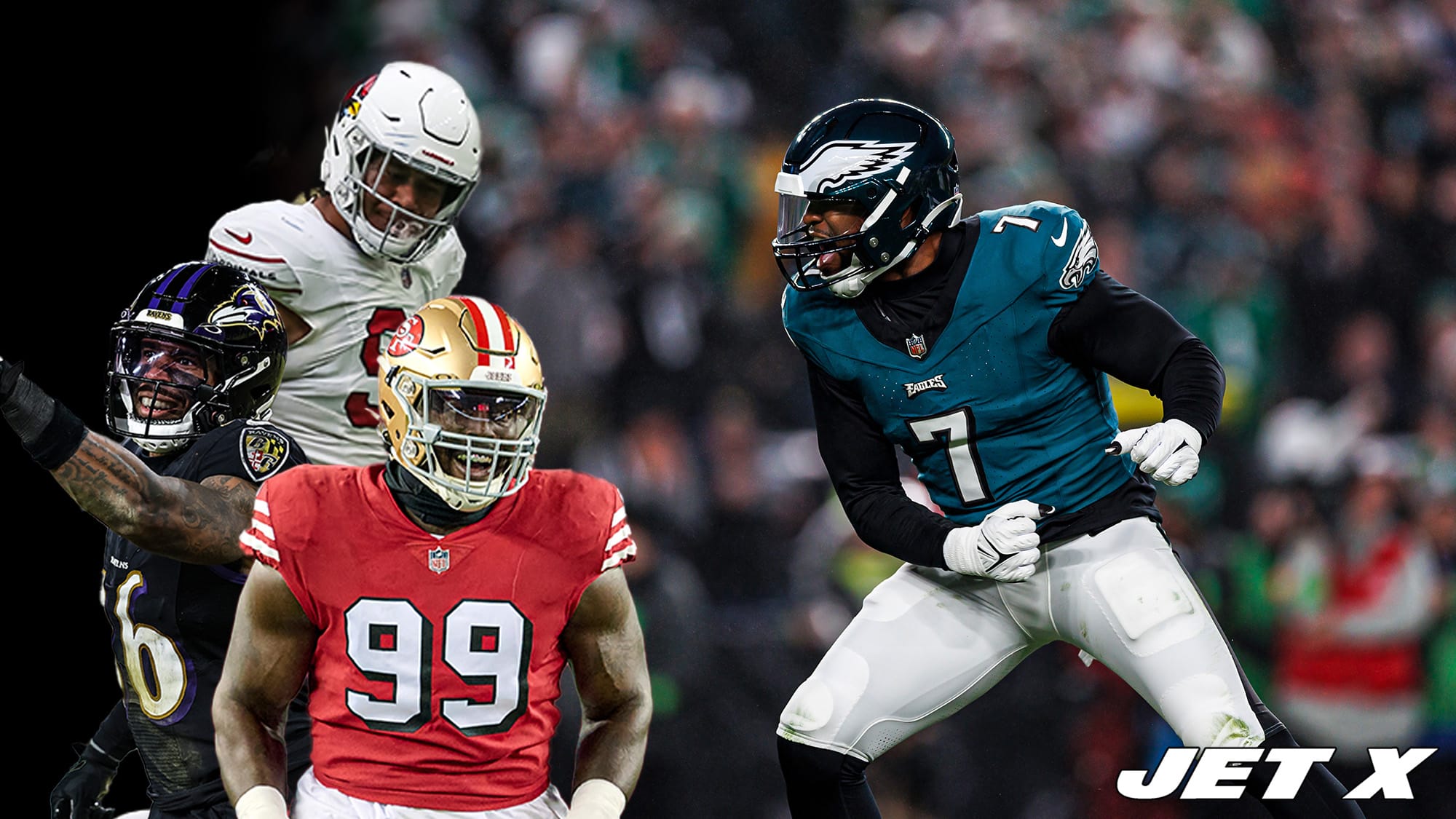As the New York Jets search for more talent at off-ball linebacker, who should they target in the 2021 NFL draft?
Despite the likely return of C.J. Mosley and the signing of former first-round pick Jarrad Davis, the New York Jets could still use some more help at the off-ball linebacker position.
In Robert Saleh and Jeff Ulbrich’s 4-3 base defense, the Jets need two every-down starters and a third linebacker who will likely rotate in for about one-third of the defensive snaps on average. Blake Cashman is on the roster to provide competition and upside, but the former fifth-round pick has yet to show enough (or stay healthy enough) to be penciled into a key role.
With all of this in mind, it seems likely that the Jets will select a linebacker at some point in the 2021 NFL draft. Who should they target? Let’s dig into the advanced numbers to get a feel for who the best values in the class might be.
Here are the prospects we will be comparing today:
- Micah Parsons, Penn St. (2020 opt-out, stats will be from 2019)
- Jeremiah Owusu-Koramoah, Notre Dame
- Baron Browning, Ohio St.
- Zaven Collins, Tulsa
- Nick Bolton, Missouri
- Cameron McGrone, Michigan
- Jabril Cox, LSU
- Jamin Davis, Kentucky
- Pete Werner, Ohio St.
- Chazz Surratt, North Carolina
- Dylan Moses, Alabama
- Garret Wallow, TCU
- Tony Fields, West Virginia
- Monty Rice, Georgia
If there are any other prospects you’d like to learn about, let me know in the comments.
2021 NFL Draft Advanced Stats:
Missed tackle rate
One of the most important aspects of the linebacker position is tackling. Linebackers are involved in more tackles than any other position, so minimizing missed tackles is even more imperative for them than it is for players at other positions.
Here is a look at each player’s ratio of missed tackles-to-tackles in 2020, and their percentile rank among qualified FBS linebackers.
*an asterisk denotes a player whose stats are from the 2019 season.
- Cameron McGrone: 0.0% (100th percentile)
- Micah Parsons: 5.4% (96th percentile)*
- Monty Rice: 5.7% (93rd)
- Jamin Davis: 7.0% (87th)
- Tony Fields: 8.8% (79th)
- Baron Browning: 9.4% (76th)
- Dylan Moses: 9.4% (76th)
- Chazz Surratt: 11.2% (65th)
- Nick Bolton: 11.9% (61st)
- Garret Wallow: 12.9% (57th)
- Zaven Collins: 13.3% (54th)
- Jabril Cox: 13.3% (54th)
- Pete Werner: 14.1% (47th)
- Jeremiah Owusu-Koramoah: 15.2% (41st)
Michigan’s Cameron McGrone had a clean 2020 season with zero missed tackles, but the sample size was small with only 26 tackles in five games. Be wary, as over a much larger sample size of 11 games in 2019, his miss rate was a more pedestrian 12.7%.
Largely considered the best linebacker in the class, Penn State’s Micah Parsons has a clean bill of tackling to back up his prestigious status, whiffing just six times against his 109 tackles in 2019. He was also an elite tackler in his only other season, posting a 6.5% miss rate in 2018.
Georgia’s Monty Rice stands out as an unheralded stud in this area. Ranked as the 173rd overall prospect at The Draft Network and No. 146 at NFL Mock Draft Database, Rice had only three missed tackles against 50 total tackles in 2020.
Generally considered a first-round prospect, Notre Dame’s Jeremiah Owusu-Koramoah checked in as the worst tackler of our 14-player sample. He missed 10 tackles while making 56 (counting out special teams). This continued his tackling woes from 2019 when he had an average-ish 12.8% miss rate with 10 whiffs and 68 tackles.
Play: 👉 the Jet X Offseason Simulator
Pro Football Focus run defense grade
Who are the best run-stoppers of the class? Here is how the group stacks up according to PFF’s run defense grade.
- Micah Parsons: 94.8 (100th percentile)
- Jamin Davis: 87.5 (98th)
- Nick Bolton: 79.0 (92nd)
- Monty Rice: 77.9 (90th)
- Jeremiah Owusu-Koramoah: 75.5 (87th)
- Cameron McGrone: 74.0 (84th)
- Tony Fields: 72.8 (83rd)
- Baron Browning: 69.6 (75th)
- Zaven Collins: 65.7 (64th)
- Pete Werner: 60.8 (50th)
- Jabril Cox: 55.0 (30th)
- Garret Wallow: 53.2 (26th)
- Dylan Moses: 51.9 (24th)
- Chazz Surratt: 35.2 (3rd)
You would think that coverage ability – not run defense – would be the greatest differentiator amongst linebacker prospects, but this leaderboard generally does a strong job of separating the best overall prospects of the class from the later-round prospects.
Projected non-first rounders Jabril Cox, Garret Wallow, Dylan Moses, and Chazz Surratt all had very rough seasons against the run. Meanwhile, Micah Parsons had the best run defense grade among all linebackers in 2019, while fellow potential top-50 picks such as Jamin Davis, Jeremiah Owusu-Koramoah, Nick Bolton, and Baron Browning were all fantastic as well.
Blitzing/pass rushing
Which linebackers were most frequently utilized as rushers? Let’s take a look at a couple of statistics in this phase – one looking at each player’s pass-rush frequency and another looking at their effectiveness.
Here is how the group compares when it comes to the percentage of their passing-game snaps in which they rushed the quarterback rather than dropping into coverage.
- Chazz Surratt: 23.3% (66th percentile)
- Micah Parsons: 22.5% (65th)*
- Cameron McGrone: 21.5% (60th)
- Zaven Collins: 20.6% (56th)
- Jeremiah Owusu-Koramoah: 19.7% (53rd)
- Nick Bolton: 17.5% (43rd)
- Monty Rice: 16.4% (37th)
- Baron Browning: 15.7% (33rd)
- Dylan Moses: 15.1% (30th)
- Tony Fields: 13.0% (21st)
- Garret Wallow: 12.4% (18th)
- Pete Werner: 10.3% (11th)
- Jabril Cox: 9.3% (7th)
- Jamin Davis: 7.5% (3rd)
None of the players in this group were used too heavily as rushers – as you would expect. It takes a complete all-around game to make it to the NFL. Pass rushing specialists are unlikely to make it onto the NFL radar.
For a glimpse at effectiveness in the pass-rush game, here is a look at each player’s PFF pass-rush grade.
- Zaven Collins: 90.6 (99th percentile)
- Micah Parsons: 86.8 (97th)*
- Monty Rice: 85.8 (97th)
- Chazz Surratt: 77.5 (92nd)
- Jabril Cox: 76.7 (90th)
- Garret Wallow: 76.7 (90th)
- Nick Bolton: 75.9 (88th)
- Tony Fields: 75.4 (87th)
- Baron Browning: 74.8 (86th)
- Pete Werner: 72.8 (83rd)
- Jeremiah Owusu-Koramoah: 72.3 (81st)
- Jamin Davis: 69.7 (73rd)
- Cameron McGrone: 61.6 (40th)
- Dylan Moses: 59.0 (29th)
While none of these linebackers were used too often as rushers, most of them were very effective in the rare instances that they were sent into the backfield.
TCU’s Garret Wallow and Tulsa’s Zaven Collins were each extremely impressive in this phase last year. Collins ranked 110th among linebackers with 51 pass-rush snaps, but he placed 33rd with 16 pressures, creating pressure on 31.3% of his pass-rush snaps (more than double the 2020 NFL LB average of 14.3%). Wallow was even more efficient, placing 137th with 47 pass-rush snaps but 13th with 20 pressures – an astronomical 42.6% pressure rate.
Coverage
To get a look at coverage ability, we’ll peek into two stats: yards per cover snap and PFF’s coverage grade.
Yards per cover snap is a simple stat, taking the number of yards that a player allows in coverage and dividing it by the number of snaps he played in coverage. It does a good job of accounting for a player’s ability to limit targets in his direction and his ability to limit the productivity of those targets. Here is how the group stacked up.
- Zaven Collins: 0.32 (93rd)
- Cameron McGrone: 0.36 (92nd)
- Pete Werner: 0.41 (89th)
- Nick Bolton: 0.60 (69th)
- Garret Wallow: 0.60 (69th)
- Dylan Moses: 0.67 (59th)
- Jeremiah Owusu-Koramoah: 0.69 (57th)
- Jamin Davis: 0.83 (44th)
- Chazz Surratt: 0.92 (35th)
- Baron Browning: 0.93 (32nd)
- Tony Fields: 0.93 (32nd)
- Jabril Cox: 0.94 (31st)
- Micah Parsons: 1.05 (17th)*
- Monty Rice: 1.34 (8th)
Three players made it into the elite ranks of this category: Zaven Collins, Cameron McGrone, and Pete Werner.
Collins gave up absolutely nothing when he was tested, yielding 59 yards over 15 targets (3.9 per target). McGrone’s forte was preventing targets altogether. He was targeted once every 14.9 coverage snaps, best among the 14 players in our group and ranking at the 91st percentile among linebackers. Werner was lucky to rank this highly, as he benefited from six dropped or poorly thrown targets. That will reflect in his PFF coverage grade below.
Monty Rice and Jabril Cox fared poorly in this category, but as we will learn below, they were actually a lot better than their yardage totals suggest. Micah Parsons is also better than his 17th-percentile ranking in yards per cover snap would suggest, but his coverage is certainly not as elite as his other skills.
Now, let’s take a look at PFF’s coverage grade. This stat does a good job of accounting for a player’s luck (how many drops and bad throws they benefit from) and tends to favor players who make a lot of big plays, such as fantastic open-field tackles underneath, tight coverage reps to force an incompletion, pass breakups, or interceptions. Here is how the group fared.
- Zaven Collins: 93.0 (100th percentile)
- Jabril Cox: 83.5 (97th)
- Jeremiah Owusu-Koramoah: 82.3 (96th)
- Jamin Davis: 72.2 (87th)
- Baron Browning: 71.9 (86th)
- Monty Rice: 70.4 (83rd)
- Micah Parsons: 68.5 (70th)*
- Tony Fields: 64.6 (67th)
- Garret Wallow: 63.0 (59th)
- Dylan Moses: 62.6 (56th)
- Nick Bolton: 60.5 (50th)
- Pete Werner: 53.3 (31st)
- Chazz Surratt: 53.2 (31st)
- Cameron McGrone: 46.5 (15th)
While Cox, Rice, and Parsons ranked low in yards per cover snap due to a high number of throws in their direction and a couple of big chunk-yardage plays that ballooned their numbers, they were generally strong in coverage.
Over 41 targets in 2020, Cox gave up no touchdowns while recording three interceptions and five pass breakups. He dominated in these categories throughout his career, finishing his four-year collegiate run (first three years at North Dakota St., 2020 at LSU) with two touchdowns allowed, eight interceptions, and 11 pass breakups.
Rice was picked on very frequently last year, giving up an absurd rate of 1.34 yards per cover snap, but he was solid on a per-target basis. He gave up no touchdowns and eight first downs over 23 targets (34.7% conversion rate) even while benefiting from almost no luck whatsoever as he had zero dropped or overthrown targets in his direction. Rice finished his tackles in the passing game effectively, making 24 tackles against the pass and missing two (7.7% miss rate).
Parsons’ coverage is undoubtedly not as impressive as his run defense or blitzing, but his production in this area at Penn State can still be considered good. He never had an interception for the Nittany Lions, but he also never gave up a touchdown over 68 targets and 539 cover snaps throughout his two seasons. In 2019, he recorded five pass breakups and made 28 tackles in the passing game without missing any, the best total among all FBS linebackers.
Cameron McGrone ranked second in this group with a 92nd-percentile average in yards per cover snap, but his coverage grade ranked way down at the 15th percentile. That’s because he was burnt toast almost every single time the ball came his way, even though those cases were rare. Over just seven targets, McGrone allowed two touchdowns and two first downs while having two targets that were dropped or misfired by the quarterback. He also had two penalties in coverage over a mere 113 snaps.
Jeremiah Owusu-Koramoah ranked disappointingly in a few of the categories throughout this piece. It’s his coverage that has him in the mix as a potential first-round pick. Owusu-Koramoah yielded only one touchdown and six first downs over 34 targets in 2020, a very low conversion rate of 20.6%. He allowed a completion percentage of 61.8%, ranking at the 90th percentile among qualified FBS linebackers and leading the 14 players that we studied today.
Zaven Collins’ 93.0 coverage grade at PFF was the best among all defensive players in the nation in 2020, regardless of position. Over 15 targets, Collins allowed just one touchdown and two first downs while racking up four interceptions (two returned for touchdowns) and two pass breakups. His total yardage through interception returns (152) more than doubled the number of yards he allowed in coverage (59).
How have these numbers affected your perspective on some of the draft’s top linebacker prospects?
As always, if you have any other players you’d like to see the numbers of or any different numbers you’d like to see, let me know in the comments.














Derrick Barnes!